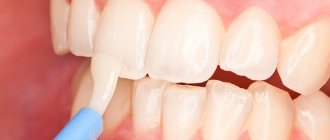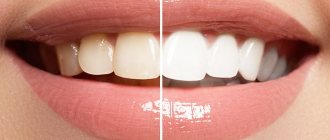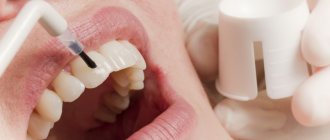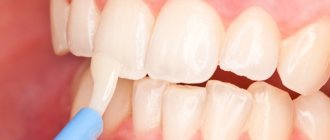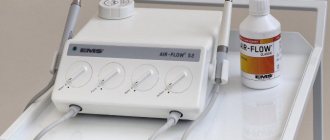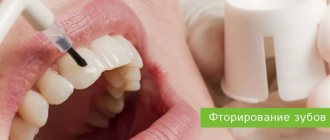Indications and contraindications Types After At home Is it harmful?
For children and pregnant women Differences from remineralization Effect Care after the procedure Fluoridation of teeth
- an effective way to protect teeth from caries and strengthen the enamel structure with the help of certain fluoridated agents.
Fluorine is an important element for the body; the daily requirement for it is about 3 mg. It comes to us with water and some food products. If it is not enough, then the connection between calcium compounds concentrated in the enamel is destroyed, the surface becomes vulnerable, which leads to increased sensitivity and damage to the tooth tissue.
What is dental fluoridation?
Fluoridation of teeth is an effective method of strengthening tooth enamel and protecting teeth from caries.
A deficiency of fluoride and calcium in the human body inevitably leads to the destruction of dentin (the main part of the tooth) and the enamel covering it. The result is increased tooth sensitivity, a tendency to develop caries, and periodontal disease.
Fluoridation is a painless and absolutely safe procedure, the essence of which is to apply a thin layer of fluoride-containing compounds (fluorides) to the surface of the teeth.
After fluoridation, it is recommended not to eat for several hours (4-6 depending on the drugs used), and also not to drink too hot or, conversely, cold drinks. In addition, you should refrain from eating solid food for 24 hours. These recommendations are due to the possibility of damaging the protective layer of fluoride applied to the teeth. If deep fluoridation has been carried out, you can eat and drink immediately.
Differences from remineralization
Any method of dentin fluoridation is part of remineralization, artificial saturation of the enamel structure with micro- and macroelements by applying dental pastes, gels rich in calcium, fluorine, phosphorus, magnesium, zinc, etc. to the surface. The procedures have the same goal - prevention of caries, strengthening of enamel and replenishment microelements lost during demineralization. If pastes and gels for remineralizing dental tissue contain several components, then fluoridation agents contain fluoride ions.
Fluoridation increases the rate of remineralization several times. Since fluoride varnish seals dentinal tubules, the use of mineral complexes should be separate. First, remineralization, the final stage is fluoridation of teeth.
Why coat your teeth with fluoride?
So what does fluoridation do? This method can be used by both adults and children to strengthen enamel and improve its strength properties.
Fluoride is an important element that not only makes enamel stronger, but also prevents the rapid proliferation of bacteria. Among other things, the resistance of teeth to an acidic environment increases, which means their surface becomes less susceptible to various types of destructive substances.
The fluoridation procedure must be repeated annually - then the teeth will be reliably protected from caries and not subject to premature destruction; The gradual leaching of calcium will stop, making the enamel stronger.
Vitamins for tooth enamel
Calcium is the main element of the skeletal system. However, the body does not fully absorb it: it is necessary to supplement calcium with vitamins D and E.
| Vitamin | Purpose | Products |
| Vitamin D | From increased sensitivity of enamel. | Fatty fish (salmon, trout, mackerel), cod liver oil, beef liver, dairy products (especially butter), egg yolk, mushrooms, sunflower seeds. |
| Vitamin E | For nutrition of dental tissues and resistance of mucous membranes to bacteria. | Sunflower seeds, soybean oil, almonds, grains and legumes, walnuts, green leafy vegetables. |
Types of fluoridation
Currently, fluoridation of teeth is carried out using two methods - simple and deep:
- Simple fluoridation . To carry out the procedure, special “spoons” are used that look like mouth guards, which are filled with a fluoride-containing composition and placed on the jaw for 10-15 minutes. To complete the full course, you need to conduct at least 10 sessions. An alternative option is simple fluoridation using a fluoride-containing varnish. It is applied with a special brush to the surface of the teeth and allowed to dry. The full course consists of 3-4 procedures, depending on the individual characteristics of the body and the drug used.
- Deep fluoridation . The main difference between this method and the previous one is the use of special enamel-sealing preparations. In addition, deep fluoridation requires careful preparation of teeth, therefore it is carried out exclusively in professional clinics. After the stage of cleaning the teeth, a special composition is applied to their surface using a tampon for 1-2 minutes, after which it is dried under the pressure of warm air. Then the surface of the teeth is stained with a swab dipped in calcium copper hydroxide milk, and then rinsed with clean warm water. The advantage of deep fluoridation is that the solution penetrates into the deep layers of enamel, making teeth much stronger. According to dentists, the effectiveness of deep fluoridation is 5 times higher than that of simple fluoridation.
How to behave after the procedure to maintain the effect?
If fluoridation is necessary, the doctor prescribes a whole complex. The patient will be given customized trays every week or if remineralization occurs. These mouthguards will be used during the home course. The patient is not prescribed any diet during fluoridation and remineralization.
“After the procedure, I recommend that patients abstain from solid foods for four hours,” says our expert, “especially if we performed fluoridation using varnish.”
Solid food is apples, crackers and anything that can harm the film. If the fluoridation process was carried out using foam or gel, then you should not drink or eat for two hours.
Benefit
As already mentioned, the main goal of fluoridation is to strengthen tooth enamel. In addition, there are other advantages of this procedure:
- The sensitivity of the teeth is reduced, so there is no discomfort when consuming cold and hot food or drinks.
- The risk of developing caries is reduced due to a reduction in the number of pathogenic bacteria and increased resistance of teeth to an acidic environment.
- Fluoridation prevents calcium from being washed out of tooth enamel, making teeth stronger and stronger.
Criticism of the technique
However, in reality, the penetrating ability of sodium fluoride is no less than that of magnesium and copper fluorosilicates. It also penetrates deeply into the cracks and microcrawls of the enamel, and calcium fluoride forms not only on the surface. In addition, caries is not affected by those areas of the surface that are easily accessible to a toothbrush, but quite the opposite - hard-to-reach places where abrasion of the CaF2 layer will be minimal. The antibacterial effect of copper does not play any significant role. There are much more active antiseptics, but for protection against caries, the construction of fluorapatite crystals is much more important.
Harm
As you know, you need to know moderation in everything. Those who like to experiment with various fluoride-containing drugs need to know the following:
- Fluorides are toxic substances that in large quantities can cause serious harm to the human body. Therefore, if you prefer to use toothpastes with fluoride, then it is better to refrain from the fluoridation procedure. And vice versa - if you have coated your tooth enamel with fluoride, then you should choose toothpastes that do not contain this chemical element.
- Fluorosis is an excessive accumulation of fluoride in the body. Fluorosis leads to brittle bones, anemia, and neuralgic abnormalities. As for teeth, when fluoride accumulates excessively in them, the enamel begins to rapidly deteriorate, which invariably affects their appearance.
In our clinic you can get a variety of dental services at affordable prices, without skimping on quality!
What is dental fluoridation?
Fluoride is one of the most important elements for teeth. It strengthens the enamel, making it resistant to acids and bacteria. Patients with its deficiency more often develop caries and pulpitis.
Normally, fluoride enters the body naturally - along with water (about 80% of total consumption) and food. But it is not always enough. In addition, certain pathological factors (systemic diseases, poor digestibility, pregnancy, etc.) contribute to its rapid consumption.
In such cases, fluoridation is recommended. This procedure involves saturating the teeth with fluoride-containing preparations. They are applied to the enamel using brushes or special trays, after which the compositions harden and form a protective film.
Mechanism of action
Enamel fluoridation products contain various fluoride compounds in high concentrations. This is usually one of three elements:
- sodium fluoride – NaF;
- amino fluoride – AmF;
- phosphate fluoride – APF.
When exposed to moisture and heat, fluoride compounds release fluoride ions, which bind to the main building element of the dental shell - hydroxyapatite. This is a calcium compound that makes up 75% of enamel.
As a result, a new element is formed - hydroxyfluorapatite or fluorohydroxyapatite. It is many times stronger and more resistant to acids than hydroxyapatite. Consequently, the enamel also becomes stronger. This mechanism of action is the preventive effect of fluoridation.
The procedure has another useful property. After applying fluorine-containing compounds, they form a layer of calcium fluoride on the surface of the crowns. It protects the enamel from the action of acids, and when the pH drops below 5.5, it decomposes, releasing calcium and fluoride ions, and saturates the dental tissues with them.
Thus, fluoride impregnation not only strengthens teeth, but also minimizes the harmful effects of lactic acid produced by cariogenic bacteria.
Indications for fluoridation
As a preventative measure, fluoridation is recommended for all patients of any age, especially children and adolescents. The process of tooth formation has not yet been completed and the degree of mineralization is lower - accordingly, the risk of developing caries is higher.
But the manipulation will be especially useful:
- with dental hyperesthesia - increased sensitivity to cold, hot, sour, sweet;
- the presence of caries at the chalky heel stage;
- before or after installing braces - to prevent demineralization of the enamel;
- if the patient is predisposed to caries;
- after whitening and professional teeth cleaning;
- in the presence of non-carious pathologies: microcracks, wedge-shaped defects, thinning of enamel;
- when the patient is diagnosed with acute fluoride deficiency;
- during the period of change of milk teeth to molars;
- with increased viscosity of saliva or insufficient secretion - in this case, the protective properties of the secretion are reduced.
Some dentists additionally recommend coating newly treated crowns: in their opinion, this will extend the life of the fillings.
Contraindications to the procedure
Despite its benefits, fluoridation can be harmful if not done correctly. The procedure is not performed if the patient:
- allergy to the components of the fluoridating composition;
- fluorosis – an excess of fluoride in the body;
- diabetes mellitus - fluoride compounds interfere with the process of sugar absorption, which is already impaired in diabetics.
Also, fluoride impregnation is useless if caries has moved from the chalk spot stage to another phase: a dark spot, affecting enamel or dentin. In this case, full treatment is carried out.
Other factors are also taken into account. Thus, children do not always allow the manipulation to be performed: some are so afraid of doctors that it is impossible to persuade them to sit quietly in a chair for even 10 minutes. Therefore, special quick-drying solutions are used for children. But it’s not always possible to apply them either.
Place of residence is also important. In some regions, the soil is excessively saturated with fluoride; it already enters the body in excess along with water and food. The procedure is prohibited for residents of such areas.
Advantages and disadvantages
Fluoridation is a controversial procedure. It has both positive and negative sides.
Among the advantages are:
- reduction in the development of caries with regular treatment every 3-6 months;
- strengthening enamel;
- minimizing the manifestations of hyperesthesia;
- preventing the leaching of calcium from dental tissues;
- protection against staining with pigments;
- cure caries at the chalk spot stage;
- duration of effect: complete leaching of elements with simple fluoridation occurs after 6 months, with deep fluoridation - after 2 years;
- prevention of secondary caries after installation of fillings;
- slight whitening effect - impregnation with fluoride-containing preparations somewhat lightens the enamel, which makes the smile more attractive.
But there are also significant disadvantages that must be taken into account before agreeing to fluoridation. These are 2 main nuances:
- risk of developing fluorosis. This disease is characterized by excessive accumulation of fluoride in the body, which leads to fragility of hard tissues. Moreover, not only teeth suffer, but all structures: bones also become more brittle, fractures often occur;
- fluoride toxicity. When there is an excess of these substances, they disrupt the functioning of the body, aggravate endocrine diseases (including diabetes), lead to anemia and diseases of the nervous system.
Harm from the procedure
You may come across the opinion that fluoridation is harmful and even dangerous. Proponents of this theory point to 2 negative points:
- In order for fluorohydroxyapatite to be produced, fluorine must contact the main building element of teeth - calcium. As a result, the compositions “pull out” the element from the enamel and dentin, and do not strengthen, but, on the contrary, make the crowns more fragile;
- the likelihood of fluorosis, which causes bone fragility. When using drugs, patients partially swallow them, which leads to an overdose of the element.
These statements are true, but with reservations. For normal teeth, the formation of hydroxyfluorapatite is not dangerous. But if they are significantly lacking in calcium, then the procedure will cause even more harm.
The picture is approximately the same with fluorosis. If you live in a region with normal or insufficient levels of fluoride in soil and water, manipulation is harmless and even beneficial. But with its excess, the risk of pathology is high.
Therefore, ideally, impregnation is carried out after testing and determining the level of fluoride in the blood. However, in practice, dentists recommend the service left and right, and even insist on it. Don't give in to their persuasion. It is precisely this kind of thoughtless imposition that is dangerous. There are certain indications for the procedure, and it is at best impractical to carry out it without clinical results.
As for the supposed spike in fluoride levels after the drugs are applied, these statements are false. According to studies published in the International Journal of Pediatric Dentistry and the Official Journal of the American Academy of Pediatrics, after the use of fluoride gels in children, the level of the element in the urine remained within normal limits.
At what age can fluoridation be done?
The procedure can be carried out from 1 year. But rarely do any one-year-old children sit calmly in the dentist’s chair, so usually their teeth are fluoridated for the first time at the age of 2-3 years.
To make the task easier, special quick-drying compounds with pleasant flavors are used for babies. They harden immediately after contact with the enamel and are not washed off upon contact with saliva.
If the baby develops caries immediately after teething, then fluoridation of the crowns begins as early as possible.
Do they do it for both adults and children?
You can coat your teeth with fluoride at any age: the procedure is just as beneficial for adults as it is for children. However, it is more often prescribed to children and adolescents, because they have a lower degree of enamel mineralization. Accordingly, caries develops more often in young patients.
The application features also differ. Children often undergo simple fluoridation using varnish. And adults are prescribed express impregnation using mouth guards or a deep type of procedure.
The frequency of implementation is also different: children are recommended to take the course every 3-6 months, and adults - from 1-2 times a year to once every 1.5-2 years.
Fluoridation of teeth during pregnancy
During the period of bearing a child, most of all nutrients and minerals from a woman’s body go to the formation of the skeleton and muscle tissue of the unborn baby. Due to calcium deficiency during pregnancy, tooth enamel is destroyed, so fluoridation during this period is very useful. However, before applying fluoride to your teeth, you should have your mouth examined and consult an experienced dentist.
It is important to remember that severe toxicosis is the main contraindication to the procedure, so it is best to plan a trip to the dentist for the 2-3 trimester, when the pregnant woman’s health improves. During breastfeeding, the fluoridation procedure will also not be superfluous.
Principles of pain management
Modern painkillers used in dental practice do not penetrate the placenta and do not change uteroplacental blood flow. They include a lower dose of the vasoconstrictor component, while the analgesic effectiveness remains high.
The drugs of choice include:
- Ultracaine.
- Scandonest (Mepivacaine).
- Ubistezin.
- Alfacaine.
It is not advisable to use lidocaine for local anesthesia, as this drug can cause convulsions, pressure changes, severe dizziness, vomiting and muscle weakness. Carrying out pain relief during tooth extraction or therapeutic treatment must be done under strict monitoring of the pregnant woman’s condition – blood pressure, respiratory rate, pulse.
Local anesthetics are not absorbed into the general bloodstream, as they are inactivated by local tissue factors. The entire volume of the anesthetic substance acts only at the site of its injection. Dental treatment during pregnancy under general anesthesia or sedation is strictly contraindicated.
Contraindications and indications
To the question “When should you resort to dental fluoridation?” there is no clear answer. Dentists suggest performing it for children and adults as a preventive measure for caries, but there are other indications for coating teeth with fluoride-containing compounds:
- Increased sensitivity. As a rule, it manifests itself in the form of discomfort when eating cold foods or drinks, fresh fruits or vegetables. Fluoridation helps strengthen the enamel, thereby reducing dentin sensitivity.
- Tendency to develop caries. If you often visit dentists for dental treatment, then fluoridation is an excellent way to extend the life of your fillings and also prevent the formation of new enamel damage.
- Recent gum disease.
- Accumulation of a large amount of yellow plaque at the base of the tooth (above the gum).
- The fluoridation procedure is also carried out after removing braces.
- For children 6 years of age and older, fluoridation is recommended to prevent tooth decay and to maintain overall dental health.
Contraindications include only individual intolerance to certain elements of fluorine-containing formulations, as well as an excess of fluoride in the body. If the patient lives in an area where the fluoride content in the water is quite high, in this case the doctor will most likely offer you other preventative procedures to protect and strengthen the enamel.
Treating stains and protecting enamel around braces
Sometimes fluoridating teeth with Clinpro™ WhiteVarnish is not enough. For example, these are the cases:
- when, after fluoridation, the patient retains tooth sensitivity in some areas
- when caries is detected in the initial stage of the “white” spot
- when a patient is undergoing orthodontic treatment and there is a risk of white chalky spots forming around the installed braces.
In these cases, the application of Clinpro® XT Varnish is recommended. During the procedure, the doctor cleans and dries problem areas, applies material to the cleaned surface and illuminates it with a polymerization lamp.
After six months, when the effect of the drug wears off, you need to visit the dentist again. The doctor will evaluate the outcome of the treatment and, if necessary, recommend repeating the fluoridation procedure with Clinpro® XT Varnish.
DLclinic dentists recommend fluoridation of teeth only in a doctor’s office, or (for home fluoridation) after consultation with a dentist, since fluoride can be dangerous to the body in excessive concentrations. Only a doctor can determine whether fluoridation is indicated for a particular patient. Carrying out the procedure independently and uncontrolled can lead to a number of negative consequences. Consult your dentist about the benefits and method of dental fluoridation recommended in your particular case.
You can find out more detailed information and schedule a consultation through the online form.
Make an appointment
(812) 232-88-25, 233-19-08
Stages of the procedure
Regardless of the chosen fluoridation method, this procedure includes the following steps:
- Oral hygiene. This can be either a full professional cleaning (removal of plaque and tartar), or a simple treatment with antiseptic dental compounds. The tooth surface must be clean before applying fluoride-containing compounds so that the mineral substances can protect the enamel.
- Thorough drying with warm air.
- Depending on the chosen method of fluoridation, either fluoride-containing varnish is applied to the teeth, or a mouth guard with a special paste is put on for 10-15 minutes.
- During deep fluoridation, the surface of the teeth is covered with an enamel-sealing liquid, which is thoroughly dried and carefully shaded. After 1-2 minutes, rinse the oral cavity.
It is also important to understand that fluoridation is advisable only on healthy teeth, so before the procedure it is imperative to sanitize the oral cavity.
Prof. hygiene with 20% discount
Moscow
Clinical researches
ASEPTA series toothpastes are distinguished by clinically proven effectiveness:
- Clinical studies have proven that regular use of professional toothpaste ASEPTA REMINERALIZATION improved the condition of the enamel by 64% and reduced tooth sensitivity by 66% after just 4 weeks.
- Clinical studies have proven that regular use of professional toothpaste ASEPTA GENTLE WHITENING for a month allows you to lighten tooth enamel by 1.5 tones, increases anti-caries effectiveness by 3.4 times and increases enamel remineralization by 2.6 times.
Sources:
- Report on the determination/confirmation of the preventive properties of personal oral hygiene products “ASEPTA PLUS” Remineralization doctor-researcher A.A. Leontyev, head Department of Preventive Dentistry, Doctor of Medical Sciences, Professor S.B. Ulitovsky First St. Petersburg State Medical University named after. acad. I.P. Pavlova, Department of Preventive Dentistry
- Report on determining/confirming the preventive properties of toothpaste “ASEPTA PLUS” GENTLE WHITENING” Author: doctor-researcher A.A. Leontyev, head Department of Preventive Dentistry, Doctor of Medical Sciences, Professor S.B. Ulitovsky First St. Petersburg State Medical University named after. acad. I.P. Pavlova, Department of Preventive Dentistry
- Characteristics of hard dental tissues in chronic kidney disease: morphology, chemical composition, possibilities of remineralizing therapy Doctor of Medical Sciences, Prof. A.K. YORDANISHVILI [1—3], Ph.D. O.A. BELSKIKH [2], MD. O.L. PIKHUR [4] 1. Northwestern State Medical University named after. I.I. Mechnikova, St. Petersburg, Russia; 2. Military Medical Academy named after. CM. Kirova, St. Petersburg, Russia; 3. Medical and Social Institute, St. Petersburg, Russia 4. Institute of Bioregulation and Gerontology, St. Petersburg, Russia
Fluoridation of teeth at home
Currently, preparations for fluoridation of teeth can be purchased in pharmacies or specialized clinics. Fluoride varnish is an effective remedy for strengthening teeth at home, but it should be used carefully and only after consultation with your dentist.
In order for fluoridation to bring visible results, it is necessary to take care of the cleanliness of your teeth. Next, you need to strictly follow the instructions included with the drug. Fluoride varnish should be used in courses - 3-4 procedures.
The most common way to strengthen tooth enamel is to use toothpastes containing fluoride. However, it is worth remembering that you cannot use these products for a long time - you need to alternate them from time to time with other drugs that do not contain fluoride.
Domestic preparations for deep fluoridation
The Russian industry, looking at the unprecedented popularity of the original drug Humanchemie, began to produce its generics. Our analogs of “enamel-sealing liquid” are “Flor-Lux kit for deep fluoridation” () and “Gluflutored” (“Vladmiva”). They also double as a “dentin-sealing liquid”:
In order to sell better, it would be desirable to support domestic medicines with references to their own effectiveness. That’s what was done, but the level of evidence turned out to be phenomenal. The developers did not bother to order a study even from the very last department of the Russian institute, and without any hesitation advertise their drug based on the result of school laboratory work:
Fluoridation and silvering: what is the difference?
The silvering method is the treatment of teeth with preparations containing silver nitrate. This method of combating caries is prescribed to the youngest children - up to 3 years old. The procedure is quick and painless: saliva is removed from baby teeth, then they are impregnated with a silver preparation. Silvering is used only at the initial stage of caries - “white spots”, and can stop the development of the disease, but does not cure it. In addition, a big disadvantage is the darkening of the teeth as a result of the procedure.
In dentistry, this method is now almost never used, giving way to a more effective fluoridation technique. The procedure is as simple as silvering, but it has advantages over the latter: fluoridation not only prevents the development of caries, but also strengthens tooth enamel.
Indications for strengthening enamel
- Caries at any stage.
- Baby teeth.
- Pregnancy and breastfeeding period.
- Discomfort or toothache while eating.
- Condition before and after teeth whitening.
- Orthodontic treatment (braces).
- Chips, scratches and cracks on teeth.
- Bite abnormalities and, as a result, pathological abrasion.
- Long-term drug therapy.

